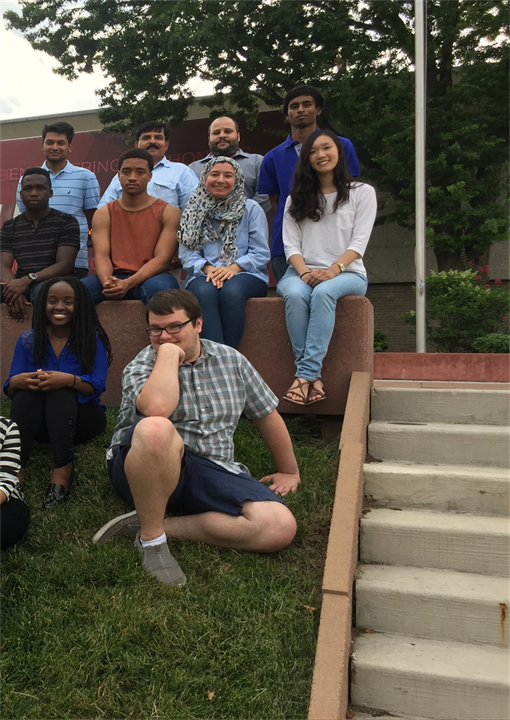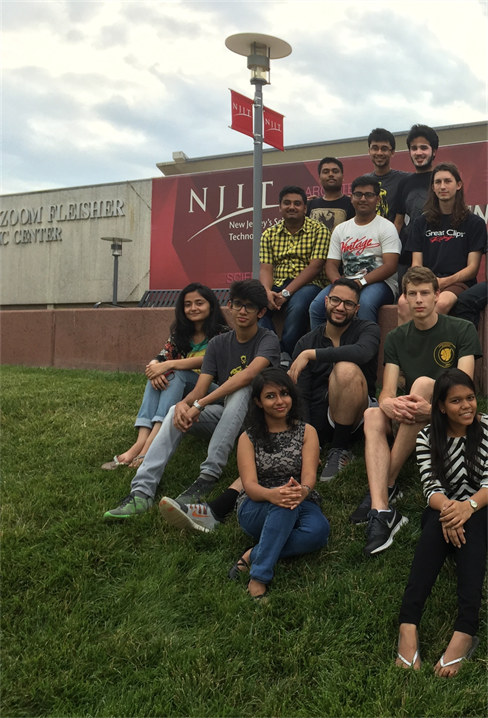


2026
NSF REU Site -
Optics and Photonics: Technologies, Systems, and Devices
Optics and Photonics: Technologies, Systems, and Devices


NJIT REU Program


The
Facts
NSF
Research Opportunity for Undergraduates: Optics and Photonics:
Technologies, Systems, and Devices
Real Research
Engage in reseach relevant to today's society
Engage in reseach relevant to today's society
A
National Science Foundation funded project intended to serve
undergraduate students interested in participating in research
projects.
For Undergraduates
Designed specifically to interest undergraduates in research
Designed specifically to interest undergraduates in research


All
Expenses Paid
REU participants recieve room and a stipend.
REU participants recieve room and a stipend.

Projects
| Project 1: Infrared
Photoconductive Photodetectors Based-on Colloidal
Semiconductor Nanocrystals Colloidal semiconductor nanocrystals are an emerging class of nanomaterials with tunable opticalproperties which are being used as basic build blocks for next-generation optoelectronic devices. As an important branch of semiconductor nanocrystals, our research group has particular strength in the infrared nanocrystals that find key applications in night-vision, solar energy conversion, optical communication, and biomedical imaging. In particular, our research in the infrared nanocrystal photodetectors offers multiple advantages over traditional bulk semiconductor detectors that suffer from high cost of device- quality material growth and complex device fabrication processes. The size-dependent quantum confinement in semiconductor nanocrystals enable precise engineering of the optical gap and the colloidal nature of nanocrystals provide low-cost, high-throughput fabrication of infrared sensors and imagers at the wafer scale. Students engaged in our research group will participate in an effort to integrate infrared nanocrystal photodetector technology pervasively into everyday objects: they will fabricate paper-based infrared detector that may potentially serves as a key sensor component of upcoming ubiquitous electronics era. Students will be involved in hands-on experimentation including semiconductor nanomaterial growth based on wet chemistry, optical property characterization, and device fabrication using unconventional semiconductor processing techniques. Role of Undergraduate Students: The participating undergraduate students will investigate theprinciple of quantum mechanics that enables optical tunability in colloidal infrared nanocrystals. Optical characterizationof these infrared nanocrystals will offer a striking demonstration of particle in a box problem. The project will further advance toward fabrication of paper-based infrared sensor. The fabrication will be based on paper (substrate), graphite pencil (electrode), and nanocrystal solution which can be easily implemented to demonstrate sensor prototypes andprovide an appealing demonstration of nanotechnology- enabled sensor technology. |
| Project 2: Optical
characterization of rat brain tissue after injury Student's Role: Undergraduate students will assemble individual components together to establish the optical characterization system, validate the effectiveness of the system on phantoms with known optical properties, collect experimental data from brain tissues and perform data analysis that may result in significant scientific discovery. These tasks are routinely conducted in our laboratory and can be accomplished by a group of motivated undergraduate students with appropriate guidance. |
| Project
3: Controlling Color Properties of III-Nitride
Nanowire Light-Emitting Diodes for Micro-Displays Project description: High Brightness light-emitting diodes (LEDs) are penetrating the lighting market and replacing the conventional incandescent light sources. These LEDs are being utilized in areas of general lighting, traffic lights, display applications and automotive lighting. However, engineering these materials has been constrained due to several fundamental limitations, including lattice mismatch and the limitation of semiconductors with tunable bandgap energy. In this regard, III-nitride nanowire structures offer flexibility to this problem, with the ability to generate high quality tunable color emission, which is more advance in contrast to the conventional thin-film structures. In this project, high color rendering properties of full-color and white-LEDs will be investigated. The design, fabrication and characterization on III-nitride nanowire LEDs for color tuning will be performed. Student's roles: Prospective students will investigate the design, device characterizations of InGaN/AlGaN nanoscale LEDs for high color rendering index (CRI). More specifically, student will work closely with graduate students: to fully understand the design and integration of full-color in high CRI white-LEDs. To understand the contribution of individual color (red/green/blue) in a while light emission at a certain CRI; to perform analysis of the device reliability, thermal stability, heat transport, and packing of nanowire LEDs. |
| Project
4: Optimization and Characterization of Low Power
In-Memory Computing Devices For In-Memory Computing or neuromorphic computing the electronic synaptic functions is realized in a metal-insulator-metal (MIM) device that operates by resistive switching (RS) where the resistance changes from low resistance state (LRS) to high resistance state (HRS) when opposite electric fields are applied. Therefore, the precise control of the switching characteristics is becoming an important issue in neuromorphic devices. Identifying CMOS technology compatible insulating dielectrics is required. ALD HfO2 will be used as dielectric material with electrode metal variation to optimize the performance. Role of undergraduate students: Under supervision of adviser and graduate student mentor the student will characterize and optimize the Metal/HfO2/Metal in-memory and/or neuromorphic devices. Some knowledge about solid-state device is preferred . |
| Project 5: Indoor Visible-light
Communication test-bed and simulator Student's Role: The key deliverable for this project is to provide an easily accessible software toolkit to evaluate the lighting and communications performance of VLC systems. The essential components of the project are broken into the 5 primary objectives: 1. Provide an open source toolkit for higher layer evaluation of RF/VLC HetNets. 2. Evaluate the physical channel effects (location, rotation, blocking). 3. Evaluate the effects of the optical front end (Source / LED, Photosensor / optics). 4. Evaluate the effects of modulation (scheme and resource allocation). 5. Evaluate the lighting / illumination in the environment. |
| Project 6: Nanoparticle Tracking
Analysis of Polymer Particles in Blood Plasma Polymer particles, such as poly(lactic-co-glycolic acid) (PLGA), are often studied as potential drug delivery vehicles, but further understanding of their behavior in the biological environment is necessary to achieve a successful drug delivery system. One major hurdle for drug delivery vehicles is getting the particles to circulate long enough to find the intended target. Many drug delivery vehicles fail at this step and are quickly shunted to liver by the immune system which identifies the particles as foreign objects. One theory for the removal of particles by the immune system is that the formation of a protein corona on the particle signals to the immune system that it is an invader. Therefore, accurately measuring the protein corona in blood plasma is crucial to understanding how the particle will behave in vivo. Typically, dynamic light scattering (DLS) is used to measure the increase in size of the particle due to the protein corona, but these measurements are done after washing the particles or are measured in diluted blood plasma. By washing or diluting the particles, the loosely bound soft corona is removed and the measurements do not reflect what the particle would experience in vivo. DLS cannot be used directly in pure blood plasma because the components of blood also scatter light. As an alternative, a method of analyzing nanoparticles in blood plasma has been developed using nanoparticle tracking analysis (NTA) with fluorescent filters. By using fluorescently labeled particles, particles can be analyzed in complex solutions such as blood plasma. The size of the particle, and thus the size of the protein corona, can be measured in pure blood plasma using this method. In this project, polymer particles incubated in blood plasma are measured using both DLS and NTA in pure blood plasma and subsequent dilutions of the blood plasma and the results from the two methods are compared. The use of this characterization method will allow for better understanding of particle behavior in the body, and potential problems related to protein corona formation can be addressed before investing in in vivo studies. Student's Role: The REU student working on this project will compare the results of both the DLS and NTA methods. |
| Project
7: Development of a pipeline for functional
near-infrared spectroscopy (fNIRS) data analyses The REU undergraduate student will be involved in constructing a GUI-based pipeline for automatic fNIRS data analyses. The three previous REU students have done commend-based fNIRS data analyses in data acquired from young adults with ADHD and group-matched controls and have developed a pipeline for the optimal paradigm of noise reduction in raw fNIRS data. The next steps of this research program will focus on integrating the automatic optimal noise reduction pipeline with automatic individual and group-level statistical analyses in fNIRS data collected from human brains. |
| Project
8: Deep Learning Acceleration with Silicon
Photonics Deep Neural Networks (DNN) have achieved worldwide attention due to outstanding image recognition over small- and large-scale datasets. Computationally, the multiply-and-accumulate (MAC) takes up to ~95% of operations in DNN models and imposes excessive energy and latency when implemented with CMOS-based components. This limits the performance and scalability of current electronic hardware accelerators and applications. In this way, silicon photonics as an alternative technology has been making a remarkable advance over the last decades by offering the intrinsic implementation of MAC operation. Role of undergraduate students: In this project, the undergraduate students will (1) explore electronic and dense photonic DNN accelerator platforms in the literature to identify the advantages and limitations of each design; (2) Learn and work with photonic integrated circuit simulators; (3) design a new silicon photonics-based hardware accelerator. A background in DNN as well as introductory-level experience in programming would be helpful. In the end, we will write up the research results in an IEEE conference paper. |
| Project
9: Indoor location determination based on VLC
communication systems Indoor positioning systems are critical to the success of location-aware computing in Internet-of-Things applications such as autonomous robot, people and asset tracking, sensor-networks, etc. In this research, we plan to investigate the use of VLC systems for determining the location of connected devices in an indoor environment. VLC-based indoor localization approaches enjoy many advantages, such as utilization of existing ubiquitous lighting infrastructure, high location and orientation accuracy, and no interruption to RF-based devices. We have built a retroreflector-based visible light localization system, which utilizes unmodified light infrastructure to localize passive IoT devices without requiring computation and heavy sensing (e.g., camera) at the devices. Role of Undergraduate Students: In this project, the undergraduate student will work on understanding the various techniques used in indoor positioning systems based on VLC, WiFi, BLE, RFID, etc. The student will also develop the software and hardware for evaluating the localization system performance. A background in signal processing as well as introductory-level experience in programming would be helpful. |
| Project
10: In-situ Plasmonic Silver Nanoparticle based
lab-on-a-chip Biosensor The recent emergence of drug-resistant pathogens has led to serious financial and healthcare woes in resource-limited settings around the world. More than 95% of the deaths caused by drug-resistant pathogens are a result of inadequate, misleading treatments and a lack of real-time diagnostic devices. Conventional methods for pathogen detection, such as batch ELISA, are time-consuming, expensive and require well- equipped laboratories with trained personnel. In resource-limited settings, there is an acute lack of equipment, devices, and methodologies to rapidly identify the pathogen and prevent their spread. Consequently, there is significant demand for devices that can rapid, ease-of-use, reliable, cost-effective, portable and does not require trained personnel to detect pathogens. We are currently developing an optical sensor in a lab- on-a-chip device with a unique plasmonic approach that will have high electromagnetic field enhancement. These should significantly enhance the sensitivity and selectivity of fluorescence-based detection compared to the batch ELISA or other, conventional methods. Role of Undergraduate Students: Different plasmonic lab-on-a-chip devices will be produced in-situ. This will be accomplished by making silver nanoparticles in-situ on a microfluidic device. Green chemistry will be used to produce the particles. The nanoparticles post-production will be collected at a point using high electric field and electro-kinetic forces. This will result in unique structures with high field enhancement. The student will be involved in optimizing the plasmonic structures and will obtain fluorescence data from the structure. Further, the student will compare/correlate the fluorescence enhancement with the electromagnetic field enhancement from the different structures. In this way, the student will arrive at the optimum structure and the requisite protocol for producing the silver nanoparticles. The student will also take UV-VIS and DLS of the nanoparticles and Atomic Force Microscopy (AFM), Raman Spectroscopy of the plasmonic structures. Finally, the student will use this plasmonic enhanced structures to test for pathogens in water and compare it to classical/standard ELISA. |
| Project 11: Exploring Dimension
Reduction Techniques for Image Processing With exponential growth in the volume of image data, it has become crucial to develop image compression algorithms for the optimal use of network bandwidth and storage space. At the same time, domain scientists need to understand the images by extracting features. It is challenging to keep the features since the information are lost due to the deep compression. The REU student work on this project will participate in evaluating the dimension reduction techniques for image processing. 1) Implement the dimension reduction techniques, including Haar Wavelet Transform, Principal Component Analysis (PCA), and Singular Value Decomposition (SVD). 2) Improve the compression ratio of compressors based on the three techniques. 3) Figure out how to achieve the best performance with different parameters, such as threshold, number of remaining features, etc. 4) Solve the run time overhead with GPU acceleration. 5) Analyze the results and explains the reasons. |
| Project 12: Machine Learning
Analysis of Lead Occurrence in Drinking Water Elevated levels of lead in Newark's Pequannock Water Distribution System have prompted the City of Newark to replace the majority of lead service lines on the system. However, drinking water may still be impacted by lead due to old building pipe and fixtures. The EPA standard measurement for lead levels uses expensive analytical chemistry that allows only for periodic sampling and testing. To ensure that residents are safe year-round, it is helpful to monitor lead concentration continuously. In partnership with researchers from the University of Michigan, professors Philip Pong and William Pennock intend to install lead and other water quality sensors on the water distribution system. Using machine learning, they hope to increase the sensitivity of the sensors, correlate increased lead levels with other water quality indicators, and also examine the co-occurrence of elevated lead levels in different parts of the system. . |




